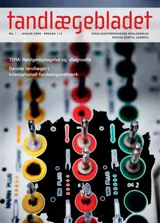Anvendelse af røntgencefalometri inden for ortodontien. En oversigt
Den røntgencefalometriske teknik blev introduceret for mere end 75 år siden. I dag anvendes profilrøntgenbilleder rutinemæssigt af specialtandlæger i orto- donti over hele verden ifm. diagnostik, behandlingsplanlægning og followup. Denne artikel giver en oversigt over teknikkens udvikling og anvendelse igennem tiden. Derudover gøres der status over teknikkens betydning for den kliniske ortodonti og ortodontisk forskning. Det konkluderes, at til trods for, at teknikken i princippet er todimensional, og at der inden for de senere år er udviklet tredimensionale teknikker til opmåling af ansigtets bløddele, kæbeskelet og tænder, så vil profilrøntgenbilledet fortsat være et vigtigt hjælpemiddel inden for den kliniske ortodonti i adskillige år fremover. Der gives i den forbindelse nogle anbefalinger til anvendelse ifm. anskaffelse af nyt cefalometrisk røntgenudstyr og software til ce- falometrisk analyse.
Craniofacial imaging in orthodontics: The roentgencephalometric technique was developed more than 75 years ago by researchers looking for a method for objective, quantitative and reproducible analysis of the relation between the dentition and the jaws and the relation between the jaws and the cranium – over time. Today, cephalometric radiographs in the lateral projection are routinely used worldwide by orthodontists for diagnostics, treatment planning and follow-up. Several other cephalometric projections have been suggested to include the third dimension, but with limited success. However, although the technique, in principle, is limited to two dimensions, it must be anticipated that it will still be in routine use for several years to come. This review deals with the development of the technique since its introduction and the development of cephalometric analyses. In addition, the article summarizes the current application of the technique within clinical orthodontics, recognizing its limitations. Finally, some recommendations are given related to the purchase of new equipment and software for cephalometric analysis.


